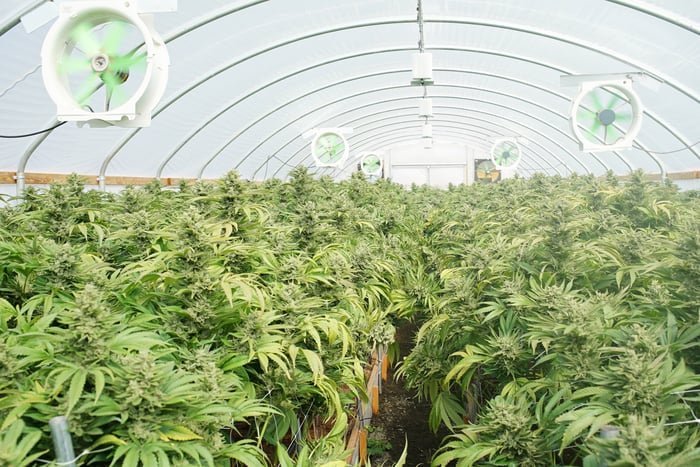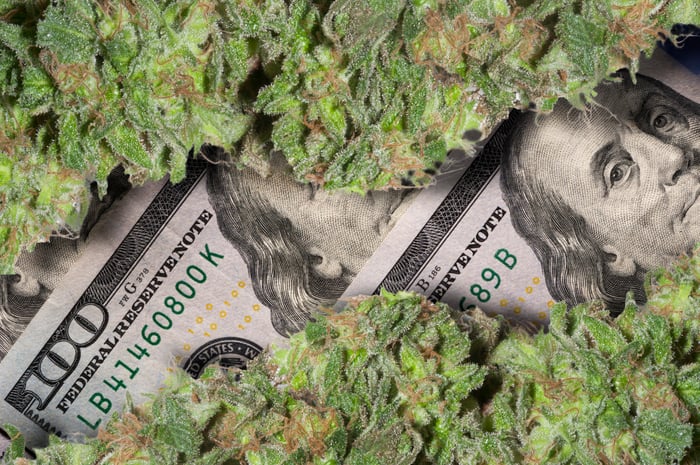It's been a banner year for the marijuana industry. Early in the year, Wall Street and investors marveled at the dealmaking, uplisting, and production capacity expansion that pot stocks put on the table. This includes all six of the largest deals we've witnessed in the history of the pot industry.
More recently, it's been all about the legalization of recreational cannabis in Canada, which became official on October 17. When the industry is fully up to speed, there's the expectation that it'll add $5 billion or more in annual sales, as well as have cannabis growers seeing green. Although it's really anyone's guess what the demand outlook will be at this point, peak production estimates for Canadian growers look to be on track to easily surpass 3 million kilograms per year, collectively.

Image source: Getty Images.
These pot growers aren't worth the risk
However, investors have to understand that no two marijuana growers are alike. Even though we've seen a number of pie-in-the-sky peak production figures, some growers carry considerably more risk than others. Though clearly up for interpretation, the following pot growers look to have the greatest capacity expansion risk, in my opinion.
The Green Organic Dutchman
Without question, the marijuana stock with the greatest built-in expansion risk is The Green Organic Dutchman (TGOD.F -55.05%).
On the bright side, this is a company with a nearly 20% equity investment from top producer Aurora Cannabis. Further, it projects to be a top-five producer when fully up to speed, assuming it can meet its lofty targets. Management has suggested that The Green Organic Dutchman could yield 195,000 kilograms at peak capacity.
Here's the issue: It isn't even expecting to complete its first harvest or sale until the first half of next year. It's great that the company believes it'll be a top-tier producer. It's also nice that the company is planning to devote around 20% of its annual capacity to its high-margin edibles and beverage division. But those promises mean very little at the moment as the company is possibly the last major grower to net its first major dried flower sale. Considering that The Green Organic Dutchman is going to be so tardy in bringing its production to market, it's not out of the question that it loses out on long-term supply deals in the process or, at the very least, nets smaller provincial deals rather than substantive ones.

Image source: Getty Images.
What's this all mean for the shareholders of TGOD, as the company is perhaps better known? It's likely that the company will be one of the last to see a major uptick in sales and, as a result, continue to produce losses. Between capacity expansion costs, an uptick in sales and marketing expenses, and share-based compensation, it could be a long time before TGOD generates a recurring profit. It's one of my top marijuana growers to avoid.
Emerald Health Therapeutics
Though far less risky than TGOD, Emerald Health Therapeutics (EMHT.F) is another name that investors probably shouldn't be considering at present.
Like TGDO, Emerald Health has a chance to be a major producer, assuming it can meet expectations. The company's joint venture with Village Farms International, known as Pure Sunfarms, should initially span 1.1 million square feet of growing space and yield 75,000 kilograms at peak production. Pure Sunfarms is retrofitting existing greenhouses from vegetable growing to cannabis production.
Emerald Health also has its Metro Vancouver grow site. Combined, the company could land between 100,000 kilograms and 120,000 kilograms in peak production, based on my estimate.

Image source: Getty Images.
The issue here is threefold. First, Emerald Health is behind many of its peers on production, with its core facilities not expected to be at full capacity until 2020. Growers that aren't able to ramp up production quickly run the risk of losing out on guaranteed supply deals. Even with plenty of land to expand Pure Sunfarms, it would take years for additional production to make an impact. And, as the icing on the cake, peak production of 75,000 kilograms across 1.1 million square feet makes it one of the least-efficient growers based on its available space.
Secondly, Emerald Health has a long way to go to build up its brand and reputation within the industry. Understandably, it's not alone in its struggle for differentiation, but there aren't any particular products, and few alternative cannabis initiatives that, to me, allow Emerald Health to stand out. Differentiating itself in a crowded field could prove difficult.
Lastly, and to echo a common theme, here, losses should continue for the foreseeable future. That makes Emerald Health an easy pot grower to avoid.
Cronos Group
Although it's a popular marijuana stock among investors, and the first weed company to uplist from the over-the-counter exchange to the Nasdaq, Cronos Group (CRON 4.66%) is the third pot stock with a lot of expansion risk.

Image source: Getty Images.
Continuing the theme, Cronos Group expects to be a top-10 producer when running on all cylinders. In July, it announced a joint venture with a group of investors to create "Cronos GrowCo," which, when complete, will offer an 850,000-square-foot facility that could yield 70,000 kilograms of yearly production. When combined with its Peace Naturals and Original BC offerings, Cronos could push for perhaps 140,000 kilograms of output, annually.
However, the concern I have with Cronos, like the two growers above, is how late it'll be in getting up to full speed. The announcement in July means that potentially half of its production isn't going to hit the market until 2020 or beyond. Though it has done a pretty good job of brand-building, at least relative to the other two growers on this list, I don't expect that to be enough to make up for its lack of near-term production.
With probably two years to go before Cronos is sitting where it wants to be in annual output, investors are likely to see either modest losses or marginal profitability, even with a surge in sales. In other words, "danger, Will Robinson."





